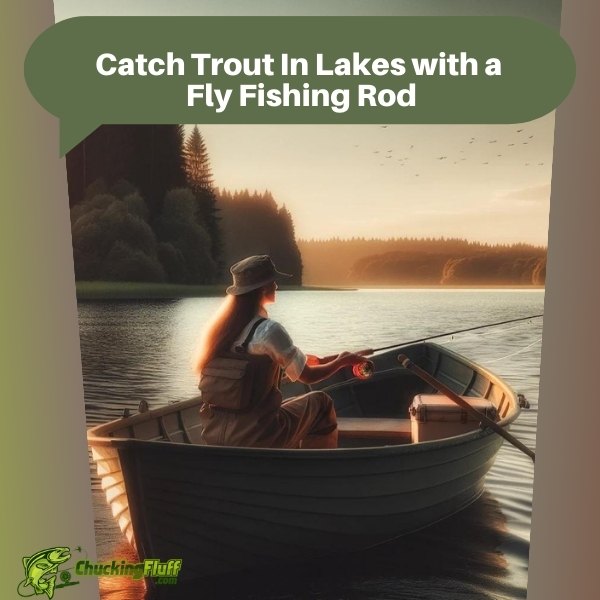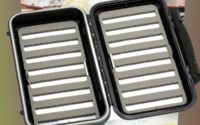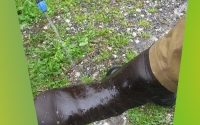| Disclosure: Just to be open and honest the buttons and links you click on in the website will in most cases take you to another website where you can purchase the products I am reviewing. As an Amazon Associate I earn from qualifying purchases. |
Catch Trout In Lakes with a Fly Fishing Rod

In the vast realm of fly fishing, still waters offer a unique and rewarding experience. Unlike rivers and streams, lakes present their own set of challenges and opportunities for anglers. Understanding the essentials of stillwater fly fishing is crucial for success on these serene expanses. In this comprehensive guide, we’ll delve into the intricacies of fly fishing in lakes, covering everything from equipment selection to presentation techniques.
Quick Post Navigation
Introduction
Fly fishing in still waters, while often overlooked, provides a rich and fulfilling angling experience. Whether you’re targeting elusive trout or feisty bass, mastering the art of stillwater fly fishing opens doors to new adventures on serene lake settings.
Understanding Still Waters
Before delving into the specifics of fly fishing in lakes, it’s essential to grasp the fundamental differences between still waters and flowing streams. Unlike rivers, lakes lack the constant current that can animate flies, requiring anglers to impart movement manually.
Types of Lakes and Their Characteristics
Lakes come in various forms, each with its unique characteristics that influence fish behavior and habitat. From oligotrophic waters with clear depths to eutrophic lakes teeming with life, understanding these distinctions is key to successful fly fishing endeavors.
Oligotrophic Lakes
Oligotrophic lakes are characterized by their deep, clear waters and low nutrient levels. While they may not support abundant fish populations, they can be home to trophy-sized trout that thrive in these pristine environments.
Eutrophic Lakes
Eutrophic lakes are nutrient-rich bodies of water with abundant plant and animal life. While they may not offer the same clarity as oligotrophic lakes, they provide ample food sources for fish and can support large populations of trout.
Mesotrophic Lakes
Mesotrophic lakes fall somewhere between oligotrophic and eutrophic lakes in terms of nutrient levels and productivity. They often have clear waters and can support healthy fish populations, making them ideal for stillwater fly fishing.
Equipment Needed
Selecting the right gear is paramount for stillwater fly fishing. From choosing the appropriate rod and line weight to understanding the nuances of different fly lines, having the right equipment can make or break your fishing experience.
Fly Rods
When selecting a fly rod for stillwater fishing, consider factors such as rod weight, length, and action. A six-weight rod around 9 to 10 feet in length is ideal for most stillwater situations, offering versatility and control.
Fly Lines
Choosing the right fly line is crucial for presenting your flies effectively in still waters. Floating lines are versatile and suitable for various presentations, while sinking lines allow you to target fish at different depths.
Reels and Other Gear
A reliable reel with a smooth drag system is essential for handling the powerful runs of trout found in productive lakes. Additionally, investing in quality gear such as sounders and anchors enhances your ability to control your presentation and locate fish effectively.
Locating Fish in Lakes
Finding fish in vast lake environments can seem daunting, but understanding the factors that influence fish location, such as water temperature and structure, can significantly improve your success rate. Utilizing underwater contour maps and sounders can provide valuable insights into fish behavior and habitat preferences.
Water Temperature
Water temperature plays a crucial role in determining fish behavior and activity levels. Most trout species prefer water temperatures in the range of 50 to 60 degrees Fahrenheit, where they are more active and likely to feed.
Structure
Understanding the structure of a lake is essential for locating fish. Submergent structures such as sunken branches and emergent structures like lily pads provide cover and habitat for fish, while changes in underwater contour can indicate potential feeding areas.
Presentation Techniques
Mastering presentation techniques is crucial for enticing fish in still waters. Whether employing a hand twist retrieve or a strip retrieve, maintaining contact with your fly and adjusting your technique to mimic natural movements is essential for success.
Hand Twist Retrieve
The hand twist retrieve or figure of eight is a slow and deliberate retrieve technique that mimics the natural movement of prey in the water. By twisting the fly line between your fingers, you can impart subtle movement to your fly and entice wary fish to strike.
Strip Retrieve
The strip retrieve involves pulling the fly line with short, sharp movements to imitate the erratic motion of injured prey. This technique is particularly effective for imitating baitfish or leeches and can trigger aggressive strikes from predatory fish.
Understanding Trout Behavior in Still Waters
Trout behavior in still waters is influenced by various factors, including water temperature, food availability, and predator-prey interactions. By understanding these dynamics and adjusting your approach accordingly, you can increase your chances of hooking into trophy-sized trout.
Selective vs. Opportunistic Feeding
Trout in still waters exhibit both selective and opportunistic feeding behavior, depending on factors such as water temperature and food availability. Understanding when trout are actively feeding and what they are feeding on can help you choose the right fly and presentation technique.
Influence of Water Temperature
Water temperature plays a significant role in determining trout behavior and activity levels. Most trout species have preferred temperature ranges where they are most active and likely to feed. By monitoring water temperature and adjusting your approach accordingly, you can increase your chances of success on the water.
Fly Selection
Choosing the right fly pattern is a critical aspect of stillwater fly fishing. From versatile patterns that mimic aquatic insects to imitations of baitfish and leeches, having a well-rounded fly selection is essential for adapting to changing conditions and enticing wary fish.
Popular Fly Patterns
Popular fly patterns for stillwater fly fishing include nymphs, streamers, and dry flies that imitate aquatic insects and other prey items commonly found in lakes. Experimenting with different patterns and sizes can help you dial in the right presentation for the conditions you encounter on the water.
Depth and Retrieve Pattern
In addition to fly selection, adjusting the depth and retrieve pattern of your fly is crucial for success in still waters. Experimenting with different depths and retrieve speeds can help you find the presentation that triggers strikes from feeding fish.
Tips for Successful Stillwater Fly Fishing
Patience, observation, and adaptability are key traits of successful stillwater fly anglers. By honing your skills and applying the knowledge gained from this guide, you’ll be well-equipped to tackle the challenges and reap the rewards of fly fishing in lakes.
Patience and Observation
Observing fish behavior and paying attention to environmental cues can help you identify feeding opportunities and dial in the right presentation. Take the time to study the water and make informed decisions based on what you observe.
Adaptability
Stillwater conditions can change rapidly, requiring anglers to adapt their approach on the fly. Being willing to experiment with different techniques, fly patterns, and presentations can help you stay one step ahead of the fish and maximize your chances of success on the water.
Conclusion
Fly fishing in still waters offers a unique blend of tranquility and excitement, with each cast holding the promise of an unforgettable experience. Armed with the knowledge and insights shared in this guide, you’re ready to embark on your own stillwater fly fishing adventures and create memories that will last a lifetime.
FAQs
What type of fly line is best for stillwater fly fishing?
Floating lines are versatile and suitable for various presentations in still waters.
How can I locate fish in a large lake?
Utilize underwater contour maps and sounders to identify potential fish-holding structures and areas of activity.
What are the advantages of using a longer fly rod in still waters?
Longer fly rods provide greater casting distance and control, particularly when using indicators or fishing deep water.
How important is water temperature when fly fishing in lakes?
Water temperature significantly influences fish behavior and activity levels, making it essential for anglers to monitor and adjust their approach accordingly.
Can I use the same flies for stillwater fishing as I do for rivers and streams?
Many popular river/stream patterns are effective in still waters, but adapting to the specific conditions and preferences of lake fish may require experimenting with different fly patterns and presentations.


